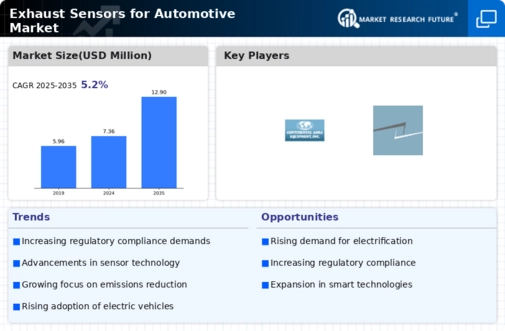Market Analysis
In-depth Analysis of Automotive Exhaust Sensors Market Industry Landscape
The market dynamics of exhaust sensors for the automotive industry are influenced by a variety of factors, reflecting the evolving landscape of vehicle technology, environmental regulations, consumer preferences, and industry competition. These sensors play a crucial role in monitoring and controlling emissions from vehicles, contributing to cleaner air and compliance with increasingly stringent regulations worldwide.
One key factor shaping the market dynamics is the growing focus on environmental sustainability and emission reduction. With concerns about air pollution and climate change on the rise, governments around the world are implementing stricter emissions standards for vehicles. This has led to a higher demand for exhaust sensors that can accurately measure and regulate the levels of harmful pollutants emitted by automobiles, such as carbon monoxide, nitrogen oxides, and particulate matter.
Advancements in automotive technology also drive market dynamics for exhaust sensors. As vehicle manufacturers strive to develop more fuel-efficient and environmentally friendly cars, they rely on innovative sensor technologies to optimize engine performance and reduce emissions. This includes the integration of exhaust sensors into sophisticated engine management systems that can adjust fuel injection, air intake, and exhaust recirculation to achieve optimal combustion and minimize pollutant output.
Furthermore, the shift towards electric and hybrid vehicles is influencing the demand for exhaust sensors in the automotive market. While these vehicles produce fewer emissions than traditional internal combustion engines, they still require sensors to monitor and regulate exhaust gases from auxiliary systems such as fuel-powered heaters and range extenders. As the adoption of electric and hybrid vehicles continues to grow, so too will the market for exhaust sensors tailored to their unique requirements.
Market dynamics are also influenced by factors such as regulatory compliance, economic conditions, and technological innovation. Compliance with emissions standards set by government agencies drives the adoption of exhaust sensors by automakers, who face hefty fines for non-compliance. Economic factors such as fuel prices, consumer purchasing power, and industry investment affect the overall demand for vehicles and, consequently, the demand for exhaust sensors. Additionally, ongoing research and development efforts lead to the introduction of new sensor technologies that offer improved performance, reliability, and cost-effectiveness, further shaping the competitive landscape of the market.
In response to these market dynamics, suppliers of exhaust sensors for the automotive industry must continuously innovate and adapt their products to meet evolving requirements and stay ahead of the competition. This includes developing sensors that are smaller, more durable, and more accurate, as well as enhancing data processing capabilities to support increasingly sophisticated engine management systems. Suppliers must also navigate a complex regulatory landscape, ensuring that their products comply with emissions standards in different regions while remaining cost-effective for automakers and consumers alike.
Overall, the market dynamics of exhaust sensors for the automotive industry are driven by a combination of regulatory, technological, economic, and competitive factors. As the automotive industry continues to evolve, with a growing emphasis on sustainability, electrification, and connectivity, the demand for innovative exhaust sensor solutions will remain strong, creating opportunities for suppliers who can effectively meet the evolving needs of automakers and consumers alike.





Leave a Comment